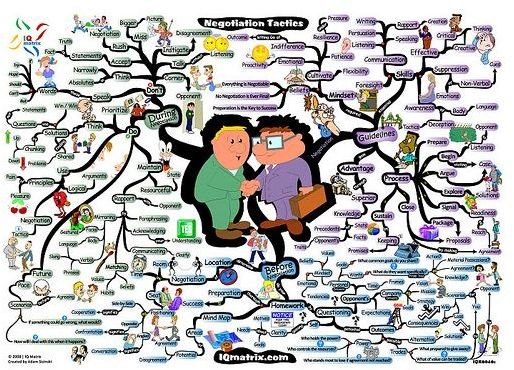Guidelines for Entrepreneurs Negotiating with Business Partners
Fixing Objectives
The primary consideration for entrepreneurs negotiating with business partners is to understand objectives clearly. Successful negotiators formulate a clear understanding of their goals and requirements before starting the negotiation process, and fix a ‘best case scenario’ objective and a ‘bottom-line’ objective, within which they negotiate.
Image Credit: flickr.com/jean-louis-zimmermann
Preparation
The success of any negotiation requires adequate preparation. This entails collecting and analyzing all data relevant to the topic of negotiation and planning for a negotiation strategy.
Good preparation entails a Strength-Weakness-Opportunities-Threat (SWOT) analysis of both one’s side and that of the competitors. Understanding the competitor’s strengths, weaknesses, and threats helps determine what is important to the other party and how far he would go to close the deal. Skilled negotiators determine the other party’s SWOT by asking probing questions during the initial stages of the negotiation.
Articulation
Very often, negotiations falter when one side is not clear on what he wants or fails to express it in clear and measurable terms. Entrepreneurs negotiating with business partners need to talk confidently and make things very clear.
The best method of articulation is that of quantitative figures based on how the proposal affects the businesses bottom-line. This helps both parties have an exact understanding of the impact and implications of the deal.
The bottom line is something that interests all business partners, and all partners would most certainly consider favorably any proposal that increases the bottom line.
Listening
Listening complements clear articulation as top negotiation tips. Very often, people remain obsessed with one’s own viewpoints and refuse to pay due consideration to the other’s viewpoint. Such a mistake is even more costly when negotiating with business partners, who most certainly have an important stake in the business. Clearly listening to the other party helps grasp the good points put forth by him or her.
Intimidation
Intimidation is a common negotiation strategy adopted by many negotiators. The basis of intimidation is the SWOT analysis of both sides, by playing on one’s own strengths and opportunities and the other party’s weaknesses and threats simultaneously. The key to successful negotiation with business partners is, however, neither to intimidate nor to be intimidated. The relationship with a business partner is long term and involves close cooperation on many aspects on a day-to-day basis. Intimidation can spoil working relationships, and eventually spell doom for the relationship and the business. Successful entrepreneurs negotiate at the same level with business partners, with the firm belief that each side has something valuable to bring to the table.
Intimidation in a negotiation among business partners rarely works anyway, as both partners would invariably have much in common in their Strengths, Weakness, Opportunities, and Threats, which explains why they came together in the first place.
Win-Win Approach

The success of any negotiation depends on both sides adopting a win-win approach. A business partner is usually a co-owner of the business or has a big stake in the success of the business. Differences might crop up regarding the ways to achieve success, but both parties negotiate with the objective of achieving success. An understanding of this fact helps in establishing common ground that makes negotiation easy.
Two ways to identify common grounds and come to a win-win solution include the SWOT analysis and the Best Alternative to a Negotiated Agreement (BATNA), or the course of action determined by a party if negotiations fail, of both parties.
Image Credit: flickr.com/roybluementhal
Multiple Solutions
Entrepreneurs negotiating with business partners need to offer having multiple solutions for the successful conclusion of negotiations. Very often, a combination of ego and the possible implications of others’ perceiving them as weak prevent the other side from accepting proposals put forth by the other side, even when convinced of the soundness of such proposals. Offering multiple solutions that more or less come to the same conclusion and allowing the other side to pick the solution he likes is one solution to overcoming this issue. Another approach is to allow the other side to tweak the proposal without altering the outcome.
Strategic Concessions
Overcoming the impasse of ego and the possible implications of others’ perceiving them as weak that prevents one side from accepting solutions put forth by the other side might at times require more than offering multiple solutions. It might require making strategic concessions, after considering the trade off between the implications of the partner walking out of the business compared to the loss incurred by making the concession.
One way to minimize the impact is to anticipate making the concession at the onset and incorporate the same during the initial rounds of discussions. While both parties understand that the other party usually asks for more in hopes of getting what he actually wants, demanding too much might be perceived as an insult and turn counterproductive.
Patience
One important quality required for successful negotiations is patience. Negotiations can be nerve-racking, and very often it becomes tempting to give up concessions just to reach an agreement. Such impatience can, however, be costly in the long run. One way to break the stranglehold of the other party is by forcing a break in the negotiations to regroup.
Walking Away
Offering multiple solutions and strategic concessions might satisfy most business partners, but very often the other party remains obdurate. A good negotiator walks away on reaching the reservation point, which is usually the same as the Best Alternative to a Negotiated Agreement (BATNA), even if risks of the negotiation breaking down cause more harm than agreeing to the unfavorable conditions put forth by the other party.
Very often, walking away from the negotiation does not end the deal, and the negotiation re-starts after a hiatus. Walking away, however, sends out a strong message that the party has exhausted all margins.
References
- Gaebler.com. Negotiating Tips for Entrepreneurs. Retrieved from https://www.gaebler.com/Art-of-Negotiation.htm on 01 October 2010
